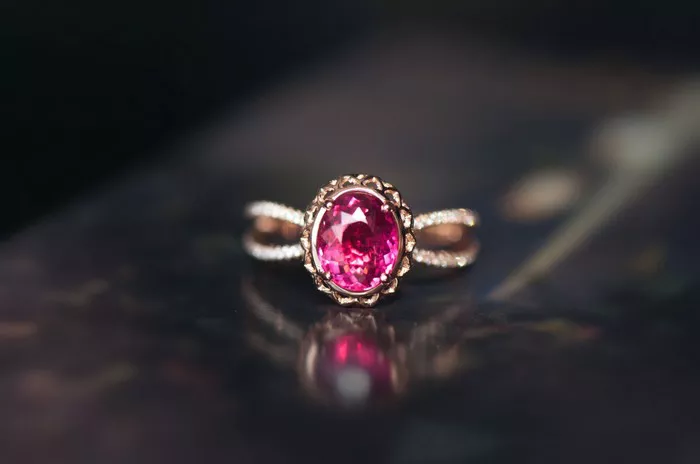Tourmaline, often referred to as the “rainbow gemstone,” is renowned for its diverse colors ranging from deep reds and blues to vibrant greens. Among these, light green tourmaline stands out for its unique charm and subtle elegance. This article aims to provide a detailed introduction to light green tourmaline, exploring its characteristics, origins, and scientific properties in a popular science style.
Characteristics and Appearance
Light green tourmaline exhibits a refreshing and soothing hue that is both calming and enchanting. Its color can vary slightly, ranging from a pale, almost mint-like green to a more vibrant, emerald-like shade. This gemstone is often transparent to translucent, displaying a glass-like luster that adds to its allure. The crystals of light green tourmaline are typically found in a complex trigonal columnar shape, with vertical stripes running along the surface.
Under gemological microscopes, light green tourmaline may reveal a syrup-like flowing structure, sometimes accompanied by a blue flash. This unique appearance is due to the internal structure and composition of the gemstone. When viewed through an infrared spectrometer, specific absorption peaks can be observed, such as those related to the bending vibrations of Si—O and the stretching vibrations of [BO3] and OH groups. These spectral features provide valuable insights into the gemstone’s chemical composition and internal structure.
Origins and Geological Background
Light green tourmaline is found in various locations worldwide, with notable deposits in places like Afghanistan, Brazil, Madagascar, and China. In China, Xinjiang Uyghur Autonomous Region is a significant source of this gemstone. The geological conditions required for the formation of tourmaline are quite specific, often occurring in pegmatite veins associated with granitic rocks.
The formation of tourmaline involves complex geological processes, including the crystallization of minerals under high temperatures and pressures. The presence of specific trace elements, such as lithium, boron, and various transition metals, plays a crucial role in determining the color of tourmaline. For light green tourmaline, the presence of iron and nickel ions in specific chemical states and positions within the crystal structure is responsible for its unique coloration.
Scientific Properties and Analysis
A comprehensive understanding of light green tourmaline requires a multi-faceted approach, combining gemological tests, spectroscopic analysis, and crystallographic studies.
Gemological Tests: Routine gemological tests, such as refractive index measurements and specific gravity determinations, provide basic physical properties of the gemstone. Light green tourmaline typically has a refractive index ranging from 1.620 to 1.639 and a specific gravity of around 3.04. These properties help distinguish it from other gemstones with similar appearances.
Spectroscopic Analysis: Infrared spectroscopy (IR) and ultraviolet-visible spectroscopy (UV-Vis) are powerful tools for analyzing the chemical bonds and electronic transitions within the gemstone. IR spectroscopy reveals absorption peaks corresponding to various vibrational modes of the chemical bonds, providing insights into the gemstone’s composition and structure. UV-Vis spectroscopy, on the other hand, reveals the absorption and transmission characteristics of the gemstone in the visible light range, which is crucial for understanding its coloration mechanism.
Crystallographic Studies: X-ray diffraction (XRD) and electron probe microanalysis (EPMA) are used to determine the crystal structure and chemical composition of light green tourmaline at the atomic level. These studies reveal the arrangement of atoms within the crystal and the presence of specific elements and ions. For example, XRD analysis can confirm that light green tourmaline belongs to the lithium tourmaline group, while EPMA can provide detailed information on the elemental composition and valence states of the transition metal ions responsible for its color.
Coloration Mechanism
The coloration of light green tourmaline is a complex phenomenon involving multiple factors, including the presence of specific trace elements, their chemical states, and positions within the crystal structure.
Trace Elements and Chemical States: The primary transition metal ions responsible for the coloration of light green tourmaline are iron (Fe²⁺, Fe³⁺) and nickel (Ni²⁺). These ions occupy specific sites within the crystal structure, known as the Y and Z sites, respectively. The presence of these ions and their chemical states influence the energy levels and electronic transitions within the gemstone, leading to the absorption and transmission of specific wavelengths of light and resulting in the observed color.
Crystal Structure and Vibrational Modes: The crystal structure of tourmaline, particularly the arrangement of silicon-oxygen tetrahedra and boron-oxygen triangles, plays a crucial role in determining its optical properties. The specific vibrational modes of these chemical bonds, as revealed by IR spectroscopy, contribute to the gemstone’s absorption spectrum and influence its coloration.
Applications and Value
Light green tourmaline is valued not only for its aesthetic appeal but also for its potential applications in jewelry and gemstone collections. Its unique color and transparency make it an excellent choice for creating elegant and sophisticated pieces of jewelry, such as rings, necklaces, and earrings.
The value of light green tourmaline is influenced by several factors, including its color intensity, clarity, cut, and carat weight. Gemstones with vibrant colors, high clarity, and well-proportioned cuts tend to be more valuable. Additionally, the rarity and demand for this gemstone in the market also play a role in determining its price.
Conclusion
Light green tourmaline is a fascinating gemstone with unique characteristics and a rich geological history. Its coloration mechanism, as revealed through scientific studies, showcases the intricate interplay of chemistry and physics within the gemstone. Whether admired for its beauty or appreciated for its scientific significance, light green tourmaline continues to captivate the hearts and minds of gemologists, collectors, and jewelry enthusiasts alike.
Related topic:
- Green Tourmaline vs. Emerald: A Price Comparison
- Can Tourmaline Be Worn Everyday
- Why Is Watermelon Tourmaline so Expensive


